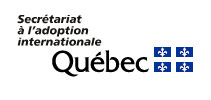International Adoption Overview
Origins of adoption
Child adoption has existed for a very long time. Related practices were apparently current in ancient times when populations exchanged children, in particular African tribes and the Inuit.
In Ancient Rome, adoption enabled a childless man to have an heir, and thus avoid the extinction of his family line.
In the Middle Ages, children were sometimes abandoned at birth and put in a hospice or a crèche. The Church attempted to avoid abandonment in public places and infanticide by encouraging placement in establishments that took in abandoned children. The so-called "desertion tower" was then made available to mothers. The tower was a place where a baby, generally a newborn, could be left anonymously and then taken in charge by an establishment. That practice was common in the 18th and 19th centuries.
Increase of child abandonments
Starting in the second half of the 19th century, voices were raised in support of needy mothers and children in an effort to curb the increase of child abandonments. However, abandonment remained a common practice not only with the disadvantaged population, but also among the middle class. Adoption became a family and local affair until the middle of the 20th century.
Rise in international adoptions
Over the course of the 20th century adoption expanded to international proportions. That situation is explained by:
- development of child welfare and social services;
- rise in the infertility rate in developed countries;
- development and evolution of global communications;
- increase in social awareness of abandoned children and children without families.
The Second World War and the Korean and Vietnam wars left thousands of children orphaned and homeless. Their adoption by soldiers and American, Canadian, Australian and European families was a humanitarian response to the situation of war orphans.
In the late 60s, the North-South axis for international adoption developed, with children from Latin America and Asia being placed in the United States and Europe. The ideology behind that axis was the industrial world's solidarity with third world countries. The North thus sought to alleviate its guilt for the abundance in which it lived by "rescuing" thousands of children abandoned in poor countries.
Starting in 1970, the rise in infertility in industrialized countries and an awareness of needy children affected by famine contributed to the popularity of international adoption. Thus, future parents turned to specialized agencies and agents to carry out their adoption plans.
In 1990, the collapse of the Union of Soviet Socialist Republics, which resulted in new States being founded, and the fall of the Romanian regime contributed to the creation of a new East-West axis. Agencies specializing in international adoption became more numerous, and international adoption saw an unprecedented increase.
Defining guiding principles
In response to what appeared to be a mass exportation of abandoned children and orphans from underdeveloped countries to developed countries, it became urgent to define principles to govern international adoption.
In 1989, the international community took an important step by recognizing standards of practice to ensure the protection of children's rights. The 1989 United Nations Convention on the Rights of the Child, widely popular with governments, fully recognizes the child as an individual and grants him or her special protection.
Four years later, concerns about international child adoption were expressed in the Convention of 29 May 1993 on Protection of Children and Co-operation in Respect of Intercountry Adoption.
That the various signatory countries adopted and enforced those conventions demonstrates their concern and their determination to provide a better framework for child protection and international adoption, while respecting the rights of children and ensuring their best interests.
Changing picture of international adoption
Statistics worldwide indicate that the international adoption picture is changing.
Although there are hundreds of thousands of children placed in establishments worldwide, most of them have not been conclusively established as adoptable. In fact, the majority of them have at least one living parent.
Prospective adopters are numerous, but the number of children proposed for international adoption is decreasing. That is a direct result of countries' desire to preserve the family, and favour the extended family or the community in caring for the child.
In actuality, more and more governments support the maintenance of the child in the country of origin, and favour family assistance and national adoption, along with a review of international adoption legislation in their country. That is why fewer children are being proposed for international adoption. Children who are in need of parents internationally more regularly have siblings, are older, or have medical or psychological particularities.
